Clouds are a staple of landscape painting. You can use them as the key feature or idea of your painting (see Issac Levitan’s Clouds below), to create a sense of moody atmosphere, or simply as a composition tool for their dynamic shapes.
Many artists struggle to paint them. That’s perhaps due to their transient, organic, and ever-changing nature, making it difficult to apply any step-by-step rules or processes. In this post, you’ll find some guidance on how to paint clouds. I cover:
- Finding Structure in Transient Forms
- Light and Color
- Nature’s Gesture
- Use of Edges
- Fitting in With the Rest of the Composition
- Cloud Reference Photos
- Master Cloud Paintings
- Key Takeaways
- Want to Learn More?
- Thanks for Reading!

(Before diving into this post, make sure to pick up a copy of my free Landscape Painting Starter Kit.)
Finding Structure in Transient Forms
Clouds are transient and fleeting by nature, but that doesn’t mean you should ignore all ideas of form and structure. Quite the opposite. Ideas of form and structure help you organize all the information and detail into something convincing on the canvas. The challenge lies in capturing these ideas without compromising the inherent transience.
Your goal is to see clouds as basic shapes and forms just as you would a tree, rock, or person. Steve Huston calls this “box logic”. What would the clouds look like if you could only see cubes, spheres, cylinders, and cones?
Try it on the following painting by Ivan Aivazovsky. What do you see in terms of shape and form?
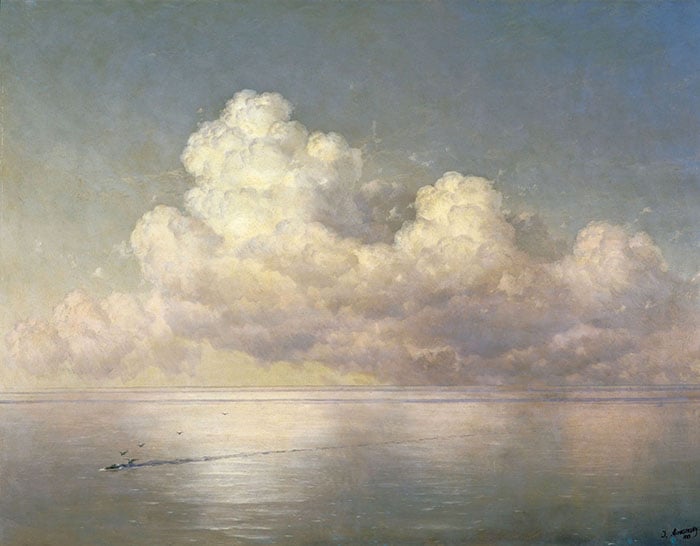
Here’s what I see (below). I’ve used boxes, but any simple shapes or forms will do as long as it’s simple! I took it a step further by suggesting the light and dark planes (the dark planes are hatched). A secondary benefit of seeing clouds as basic forms is it helps you conceptualize ideas about light and shadow. Otherwise, you will need to rely almost entirely on observation and perhaps a bit of guesswork.
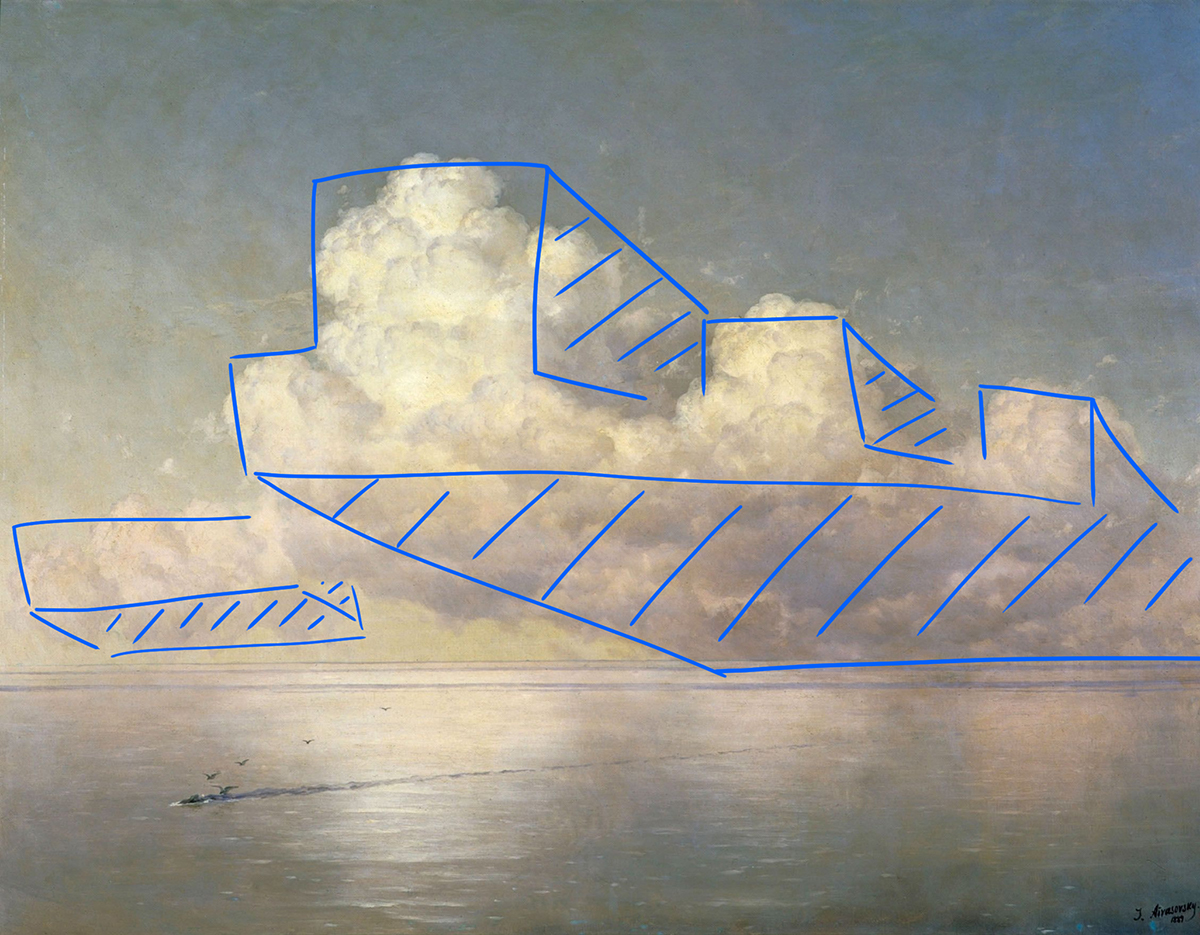
In the above example, I translated the clouds into basic three-dimensional forms. But sometimes shape is more appropriate, especially when the clouds are tightly compacted in the sky, diminishing any sense of distinct form. (Note: Shape is basically a flat or two-dimensional version of a form-a circle is a flat version of a sphere).
Take Isaac Levitan’s A Stormy Day (below). Clouds dominate the sky, so much so that it’s impossible to make out any distinct forms. Depth is implied by the overlapping shapes rather than the rendering of three-dimensional forms. Shape is therefore more effective in simplifying all this detail.
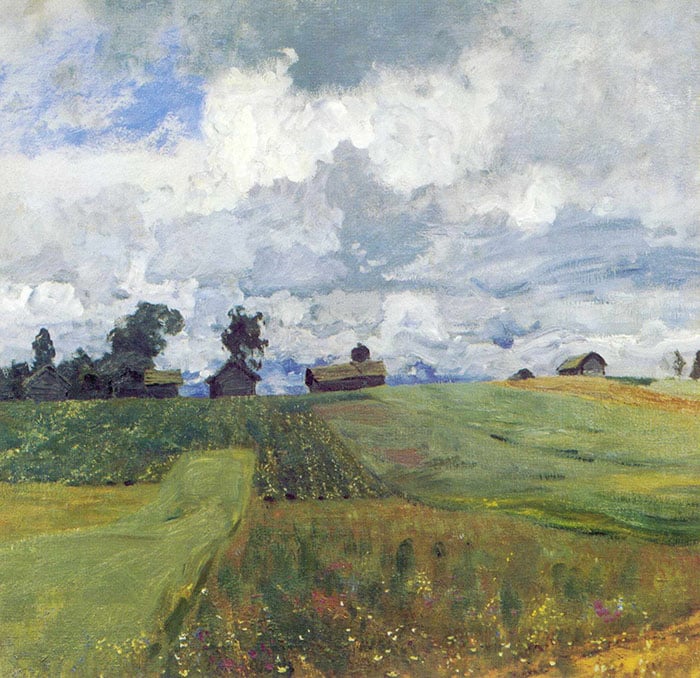
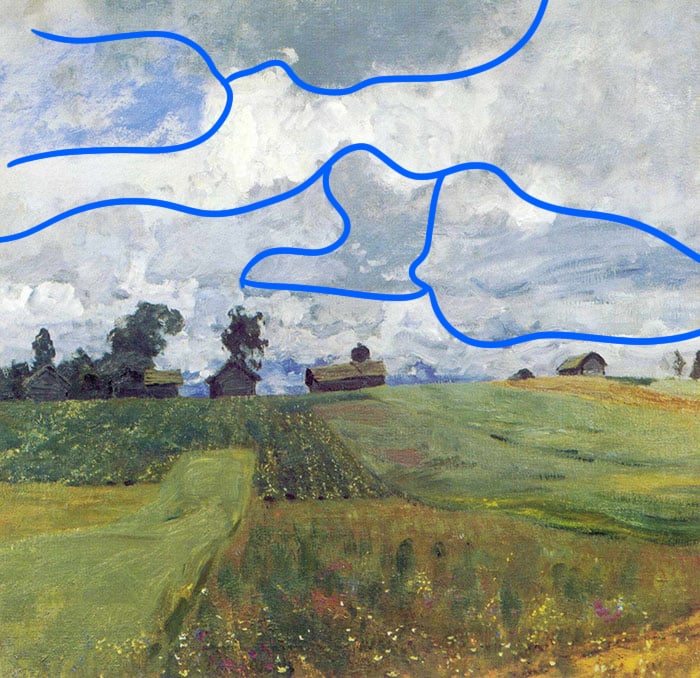
And don’t forget negative space (the areas between the clouds-typically blue sky). I’ve indicated the negative space in the below painting.
As with many aspects of painting, there are two ways you could deal with positive and negative space:
- You could paint in the clouds first (positive space) and then fill in the gaps with color (negative space); or
- You could start with the blue sky (negative space) and then fill in the clouds (positive space).
Most aspiring artists ignore option 2-they focus on painting things rather than the area between things. There’s nothing wrong with this approach, but sometimes it’s more effective to focus on the negative space first.
Negative space also acts as a useful audit tool to check if your positive space is correct. For example, say you are painting clouds in the sky. You start by outlining the shape of the clouds. If your drawing is correct, then the shapes representing positive space should match the reference. If not, there’s something wrong with your clouds. Errors often require a change in your perspective before they rear their heads.
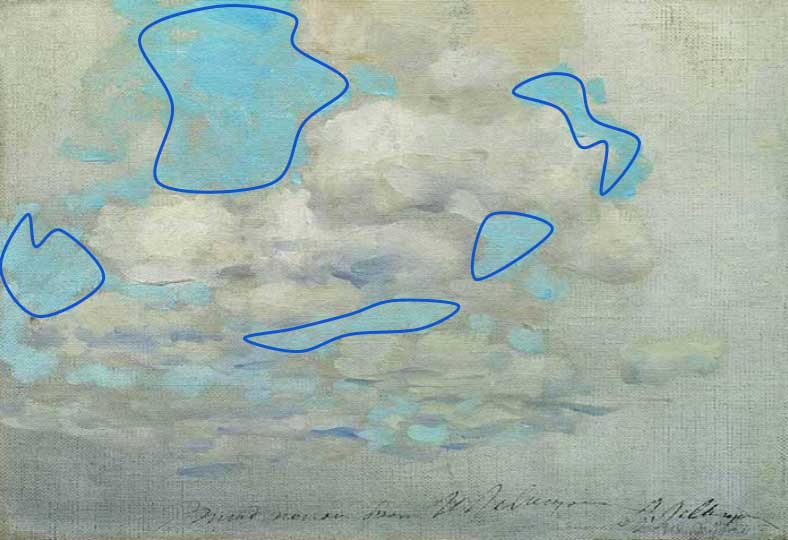
Try it yourself. Go outside on a cloudy day and try to “see” the clouds as basic shapes and forms. Do this enough and it’ll eventually become second nature-you will be seeing the world as an artist.
Light and Color
(Note: This section applies more so to clouds that have a distinct form, with light and dark planes, rather than clouds that are better depicted by a flat shape).
Once you see clouds as basic shapes and forms, you can apply the laws of light as you would to any object.
To keep things simple, assume there’s one light source-the Sun. Each cloud equals a simple form, be it a box, sphere, cylinder, cone, or combination. For each change in plane, there’s a change in lightness. Planes facing towards the light will be lighter than planes facing away from light. Areas in light should be distinct from areas in shadow. Be selective with your highlights and dark accents-less is more!
The position of the Sun in relation to the clouds determines which planes are hit by light and which are in shadow. The nature of the light (strong, weak, direct, diffused, warm, cool, etc.) influences the level of lightness (value) and color temperature.
Get these fundamentals right, and most of the hard work is done. You’ll be free to add your own creative flair without compromising the sense of realism, whether that be energetic brushwork, subtle color transitions, a burst of light, or a rich, dark accent. See John Singer Sargent’s study below-it’s oozing with creative flare, but the fundamentals are strong as always with his work.
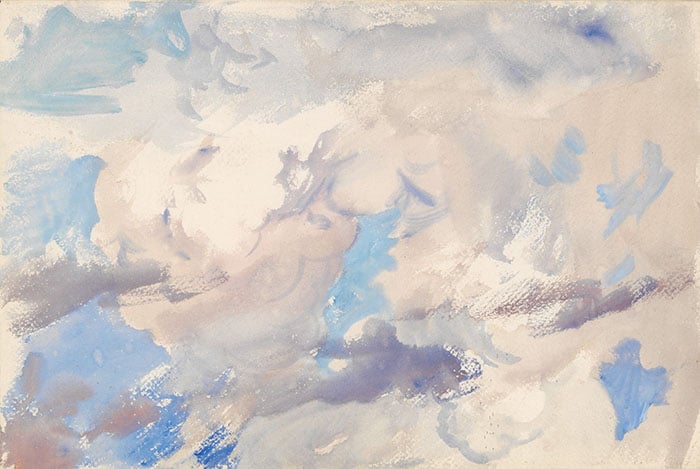
I’ll run through some examples of how the laws of light apply to clouds, starting with Sargent’s Palazzo Labia. Venice. Sargent didn’t mess around with subtle mid-tones-he kept things simple with distinct highlights and shadows. This plays well with the painting’s loose style (highly rendered clouds would surely look out of place, no matter how skillfully painted).
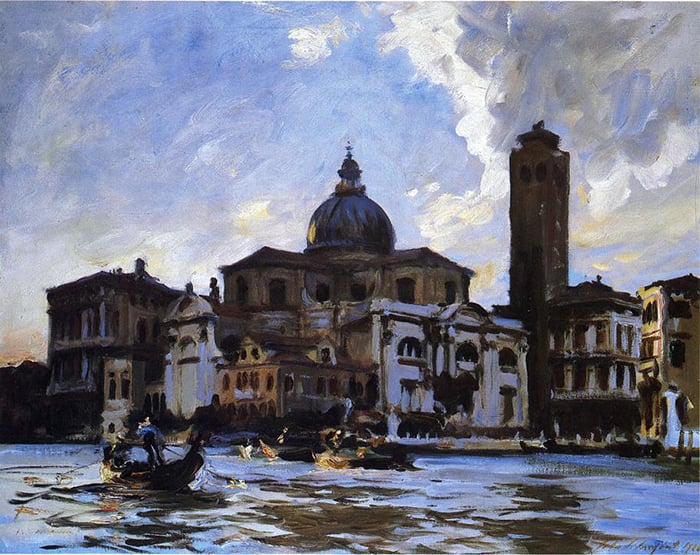
Below is a stunning painting by Claude Monet. The sky is a battle between clean yellow highlights and scattered shadows. I can’t easily explain how the laws of light work in this painting, but it works nonetheless (as is the case with many great Impressionist paintings).
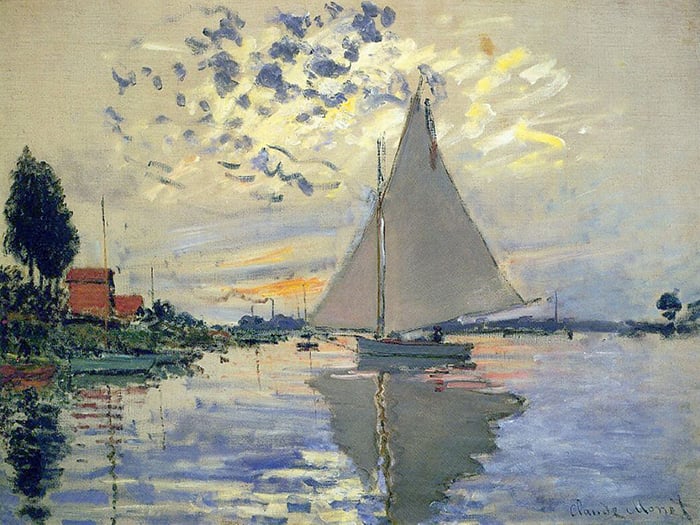
Here’s a moody seascape by Joaquín Sorolla. Instead of painting every detail, Sorolla picked a few important highlights and dark accents to do all the talking. Also notice the positioning of the highlights close to the dark accents, making them both pop.
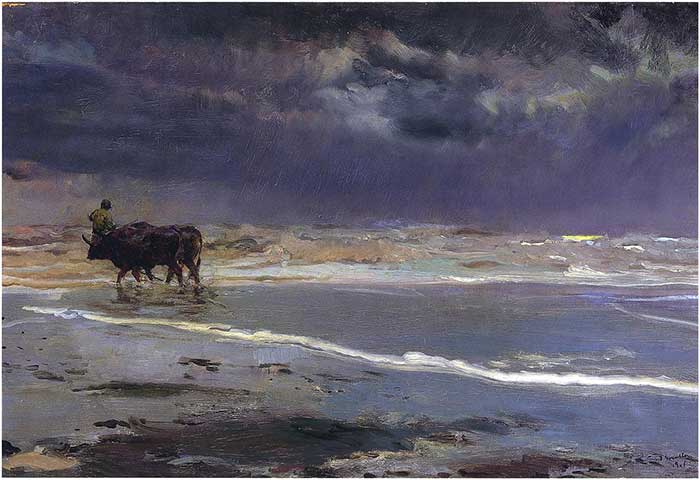
John Constable was always dramatic in his depictions of clouds and the landscape in general. He used his creative license to really push the highlights and shadows, exaggerating the effects of light.
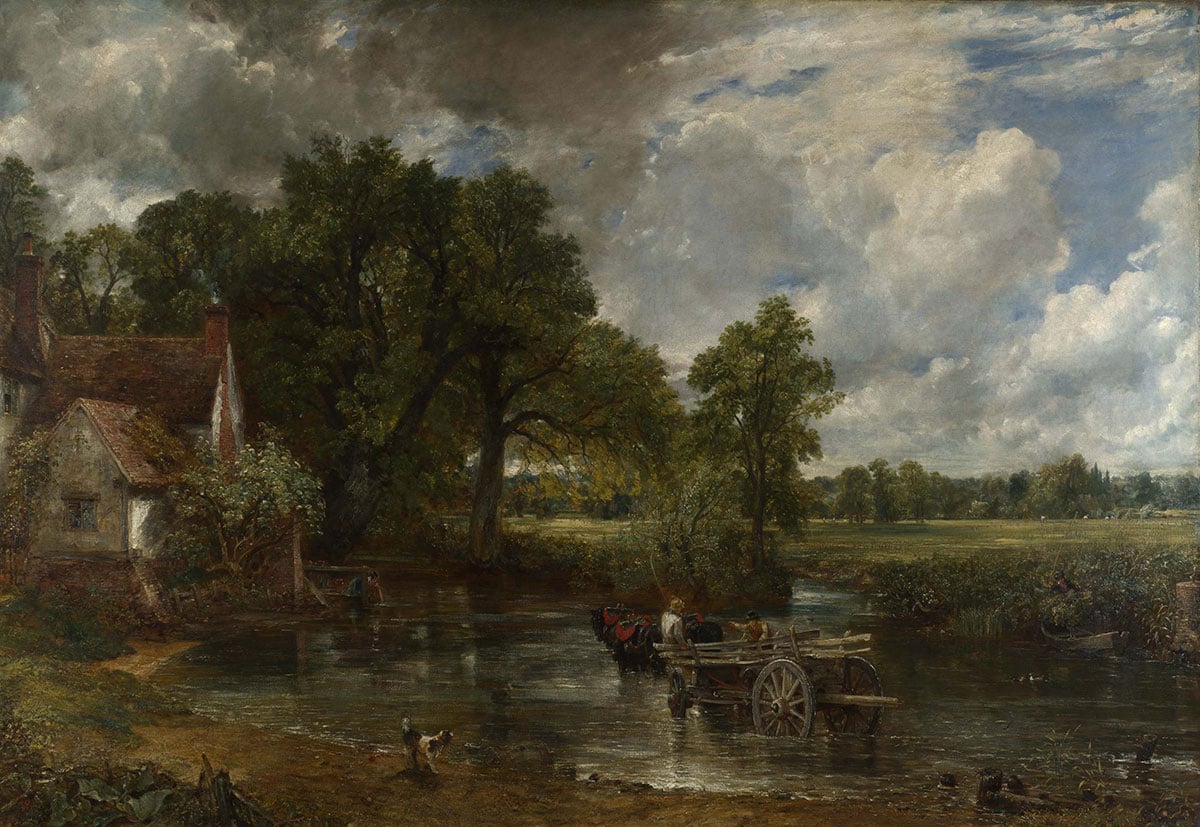
In terms of color, clouds are typically limited to white, grays, and other weak tones. Rarely will you see clouds bursting with color, bar maybe a vivid sunset. That doesn’t diminish the importance of color, it just means you need to be restrained in your use of it. Think subtle color transitions rather than bravado statements like you see in Vincent van Gogh’s work.
Your color selections will depend on factors such as:
- The nature of the light (how warm or cool it is).
- The overall key (value range) of your painting. In other words, how light is your lightest light, and how dark is your darkest dark?
- The overall color theme of your painting. You may decide to use colors that reflect the overall theme rather than the colors you actually see.
Whatever you do, don’t default to pure white for lights and dull blue or gray for darks. Have a strategy; think critically about what colors you should use and why. If you’re ever in doubt, fall back to observation.
In my sunset painting below, the colors I used for the clouds were based on observation and the overall theme of the painting. I used more blue than I actually saw, as it fit in better with the theme and created a sharper contrast against the sunset’s warm colors.
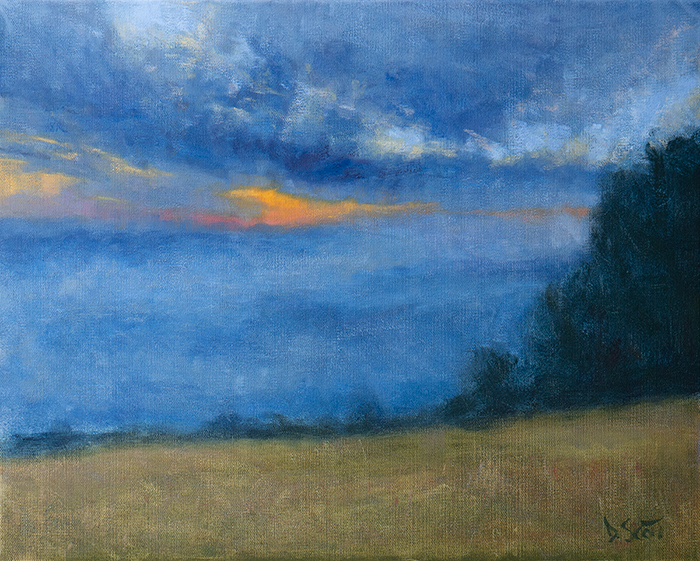
Nature’s Gesture
Gesture typically refers to the movement and flow of the human body. Portrait painters understand it deeply. But nature also has a gesture; it’s just hidden behind all the details.
Capturing nature’s gesture will inject life and movement into otherwise static and flat clouds.
A simple way to understand gesture is to look at a cloud, or a group of clouds, and try to capture it using a single line. Think of this as nature’s gesture line. Build structure and form around it and let it guide your brush.
I’ve suggested the gesture line(s) in the following paintings. Keep in mind, this is not an exact science; it’s just how I perceive gesture and movement.
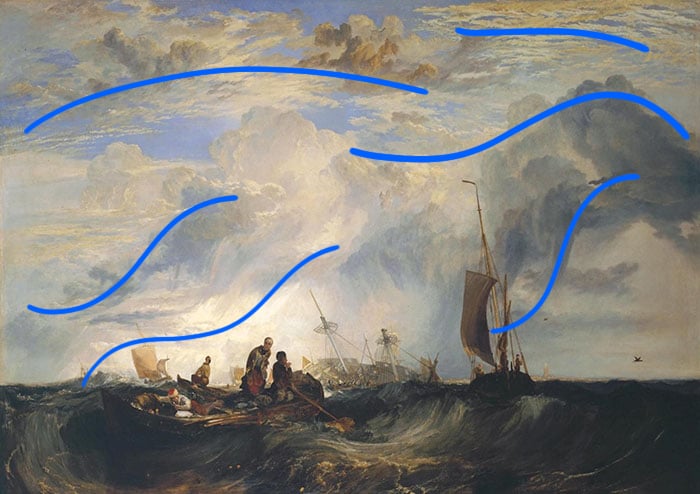
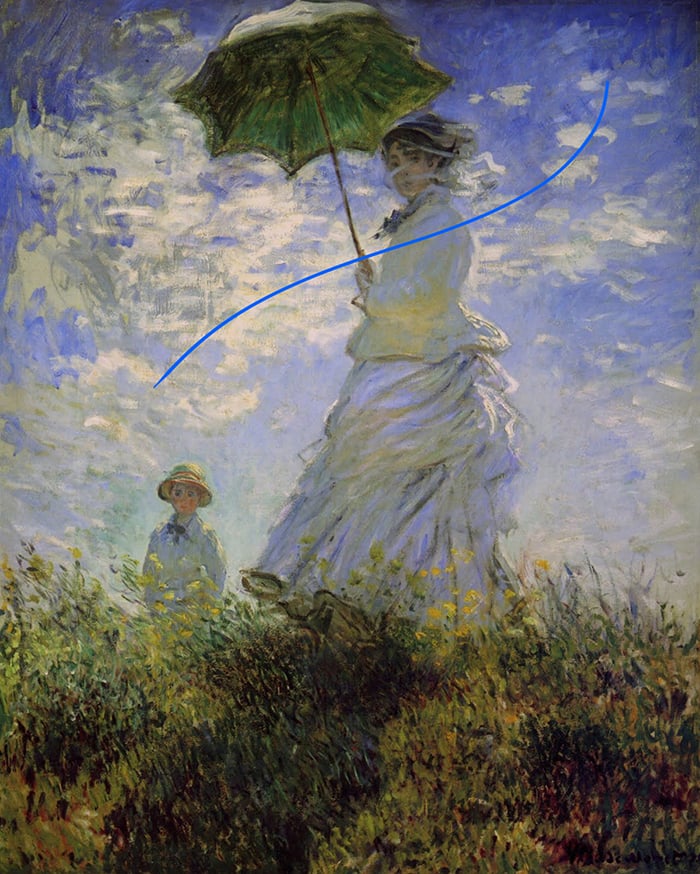
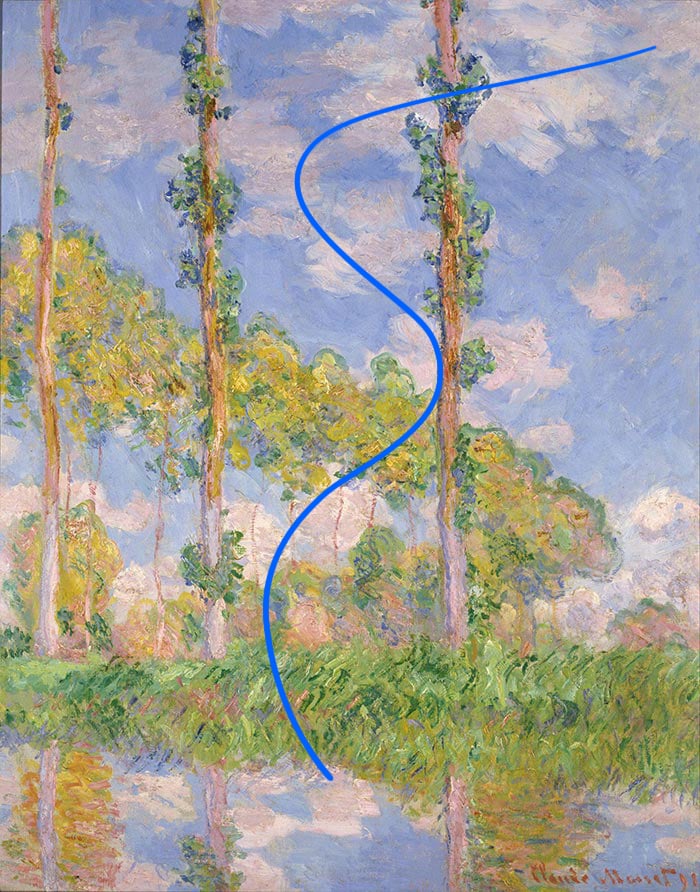
Try it yourself. Where is the gesture in Levitan’s painting below?
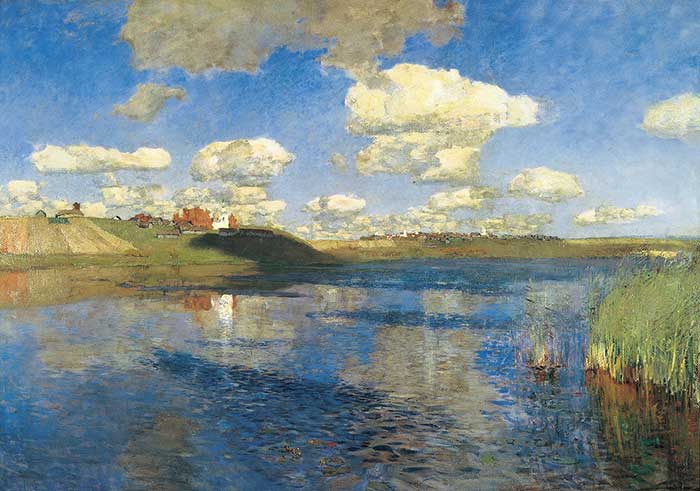
Use of Edges
Barring some stylistic choices, you will typically use soft edges for clouds, with hard edges reserved for highlights and perhaps dark accents. That’s because clouds are soft, fluffy, and transient by nature. Overuse of hard edges can make your clouds appear rigid and solid.
In Constable’s Rain Over the Sea, hard edges are only used in the sky for some highlights; everything else is soft. The sea, on the other hand, is filled with hard edges, giving a sense of relative solidity (even if it is water). The horizon line is also represented by a hard edge separating the sky and sea.
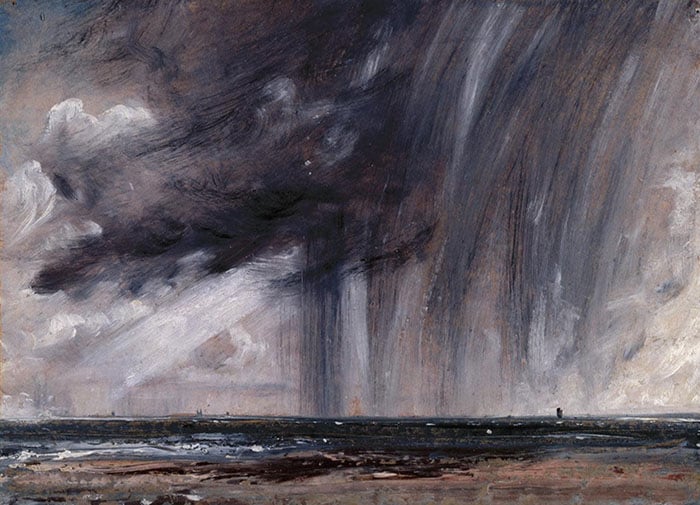
Fitting in With the Rest of the Composition
It doesn’t matter how well you paint something if it doesn’t fit in with the rest of the painting. How often do you see paintings where the clouds, although meticulously painted, appear like cardboard cutouts glued onto the painting.
Every mark you make on the canvas must be done with the intention of improving the painting as a whole. This runs true for clouds, trees, rocks, water, people, edges, colors, shadows, or any part of the whole.
The key is to stay in touch with the big picture rather than getting lost in the details. Step back from your painting often and purposefully. Wander around. Interrogate it. Look for problems with the big picture, don’t hide from them. (If you spend all your time painting with your eyes glued to the canvas, you might overlook the glaring mistake that can only be seen from afar).
Think about many of the great Impressionist work. From up close, you see a mess of color, but it all comes together as you step back. The Impressionists painted with the big picture in mind. You should do so as well, regardless of your preferred style.
In my painting below, the clouds represent strong shapes in the overall composition. I didn’t render them with intricate detail or capture every slight change in color. Instead, I simplified them to fit their role in the painting.
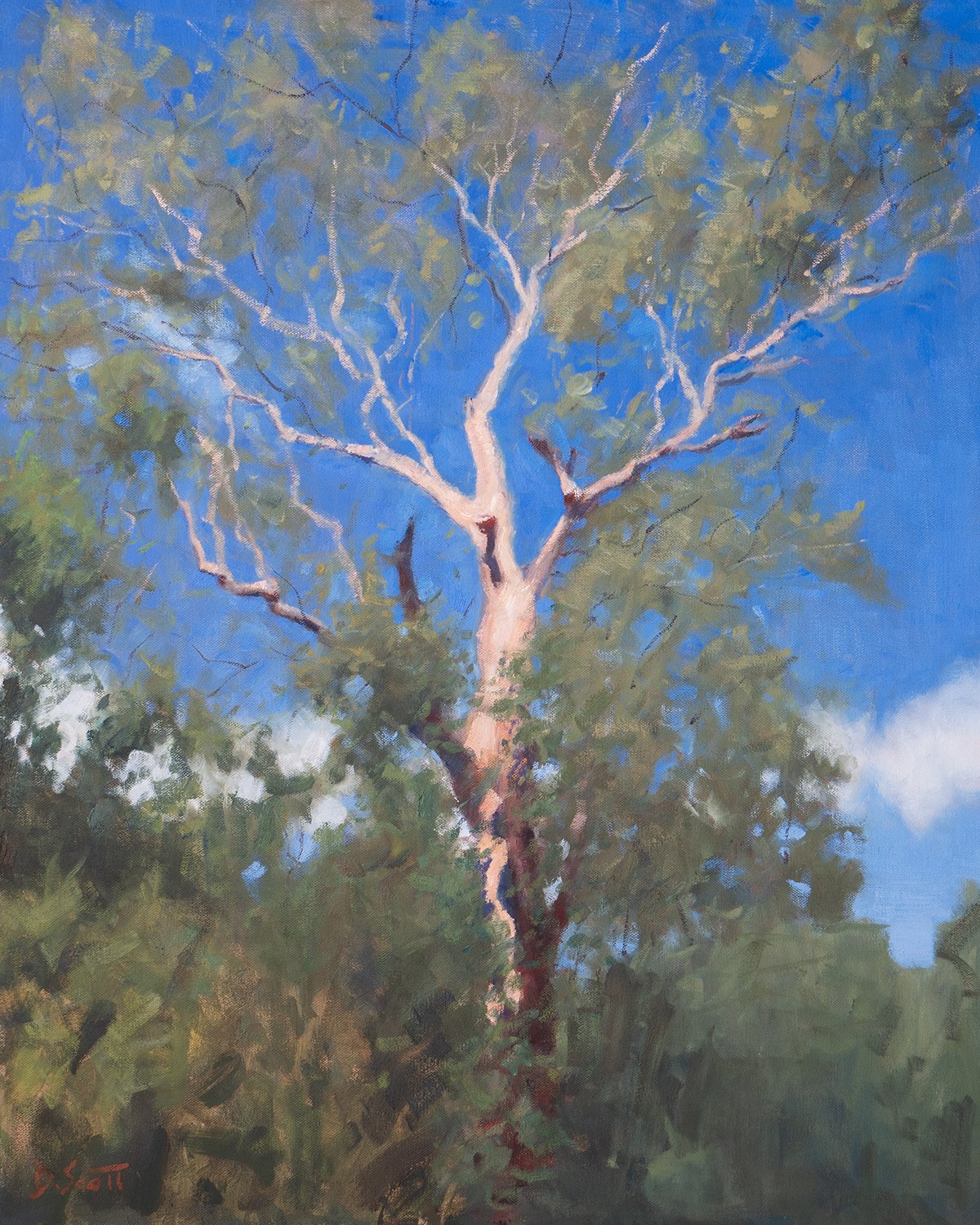
Clouds are a key feature of Gustave Courbet’s Calm Sea. But they aren’t rendered with fine detail; rather soft edges, simplified brushwork, and compressed values (the lights and darks are restrained). This fits in with the rest of the painting and allows the two boats resting on the shore to command attention.
On a separate note, notice the sense of balance in this painting. The sky, ocean, and shore take up a vast majority of space, yet it’s the small boats resting on the shore, and even the ones sailing in the distance, that command attention. An interesting contrast between big and quiet against small and noisy.
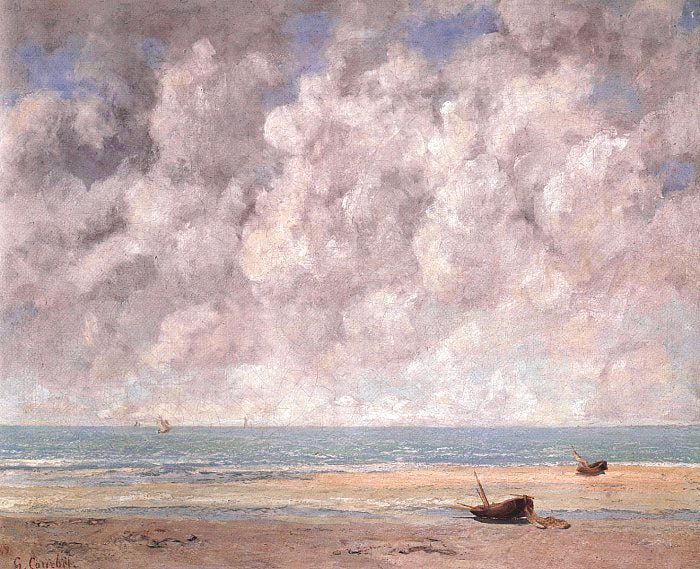
In Monet’s Impression, Sunrise, the clouds are there for atmosphere, nothing more. There’s so little rendering that the clouds blend seamlessly into the rest of the painting.
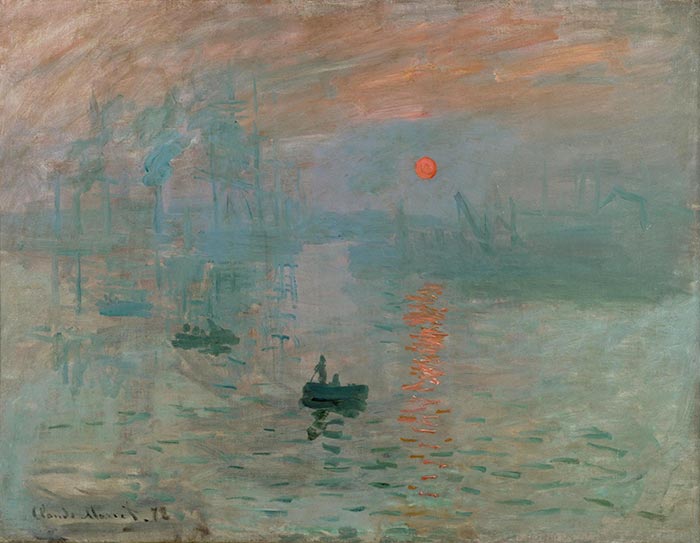
In Levitan’s Vladimirka, the clouds are rendered with rather fine detail, yet the sky as a whole is subtle compared to the land of dark colors and sharp contrast. Notice how Levitan created depth in the sky by picking out a few clouds to detail, effectively pulling them forward in perspective.
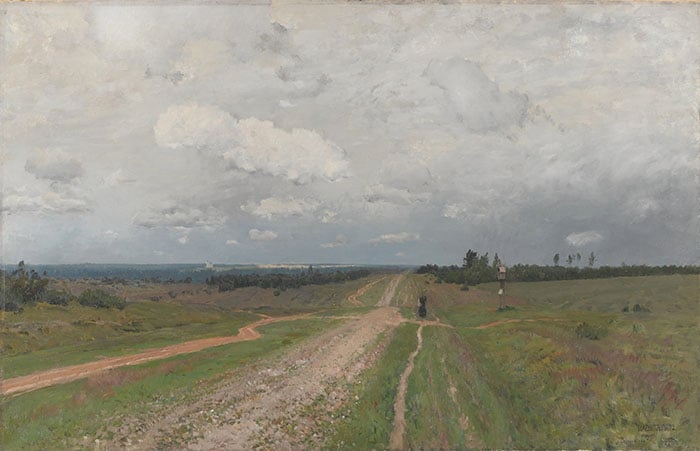
Ivan Shishkin’s painting below is a great demonstration of relativity. The clouds were painted with intricate detail, powerful highlights, and crisp edges, yet I wouldn’t say they’re the focal point of the painting. The land, despite taking up less space in the painting, features a similar level of detail, along with dark colors and far greater contrast.
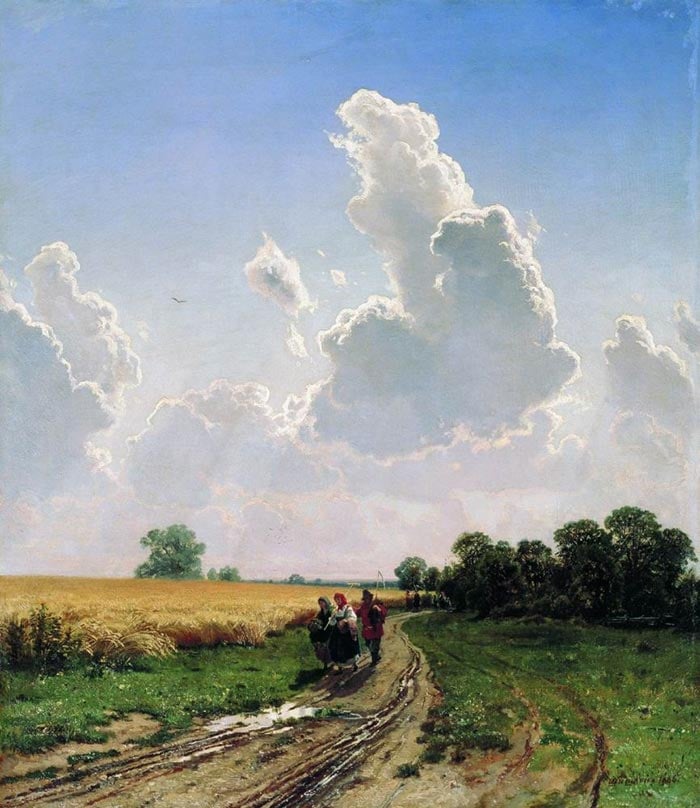
Cloud Reference Photos
Here’s a gallery of cloud reference photos for you to use as reference material. You can see an example of what’s in the gallery below.
Master Cloud Paintings
Here’s a gallery of master cloud paintings for you to use as inspiration. You can see an example of what’s in the gallery below.
Key Takeaways
- Clouds are fleeting and transient, but that doesn’t mean you should ignore structure and form. Seeing clouds as basic shapes and forms will help you simplify and organize all the information.
- If you cannot make out distinct forms, use shape to simplify the clouds.
- Focus on getting the fundamentals of light and color right first, then inject your creative flair, if at all.
- Your use of color will depend largely on the nature of the light, the overall key of your painting, and the overall theme.
- Much like the human body, nature also has a gesture. It’s what will give your clouds a sense of life and movement.
- You will mostly be dealing with soft and lost edges, plus a few hard edges for highlights and perhaps dark accents.
- It doesn’t matter how well you paint the clouds if they don’t fit in with the rest of the painting.
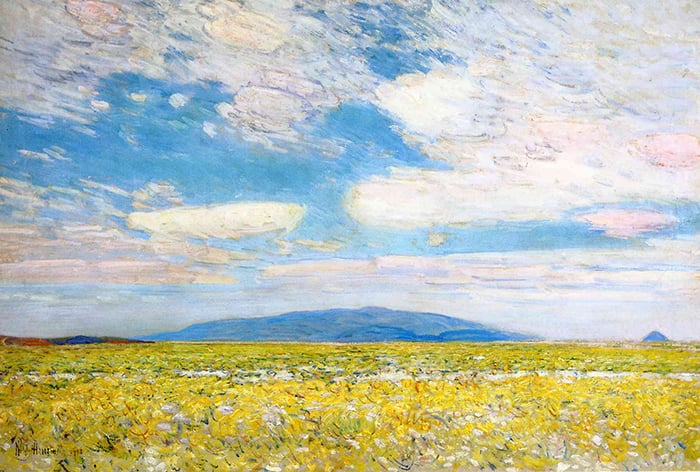
Want to Learn More?
You might be interested in my Painting Academy course. I’ll walk you through the time-tested fundamentals of painting. It’s perfect for absolute beginner to intermediate painters.
Thanks for Reading!
I appreciate you taking the time to read this post and I hope you found it helpful. Feel free to share with friends.
Happy painting!
Dan Scott

Draw Paint Academy

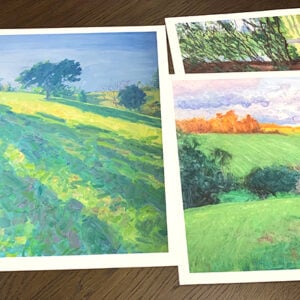
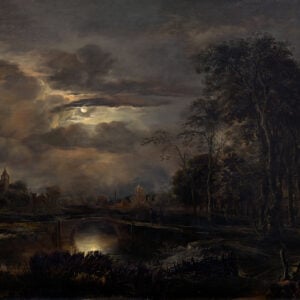
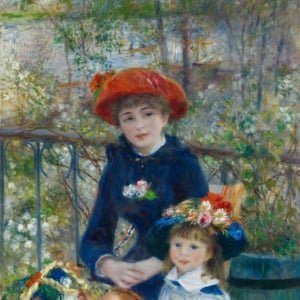

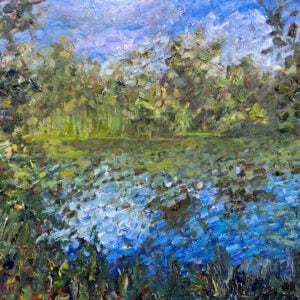
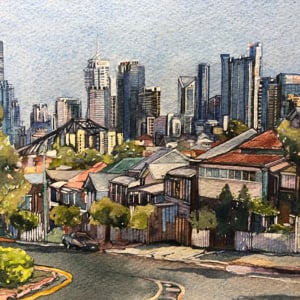
this is very informative. I am enjoying all of the “lessons” coming into my mailbox. Thank you.
Good guide lines
Loved the article. A great review and your through the work of some favourite mentors.
Really helpful and informative great to get these free tips
I have been dissatisfied with my clouds, after this lesson I decided I need to spend enough days doing cloud studies to start being happy with this element of my work which is largely landscapes. Thank you.
Same! Thank you.
Your tips are interesting and all that you say is easy to understand. I am a painter and churn out lots of work and I’m told that I am artistic. But technically I feel a bit hopeless. I go through agony trying to draw arms and hands etc but I do persevere. I wish you were here to show me more.
Been painting since 1976. Seen plenty of tips from good and not so good for style and teaching skill. Dan Scott is the most gifting giver, whom I also welcome to my mailbox.
EdZee
Thanks for your insight.
Yes this is very helpful !
Using gesture – line of action- is a brilliant idea! I hadn’t thought of doing that for clouds (just people) but it helps in understanding the movement/shapes of the clouds
I find clouds much like rocks: if I think too much about them I can’t do them. I also think many otherwise excellent painters do really abominable clouds, and many do highly stylized clouds: They never look right except in the context of the painting. ( Sargent for example. )
Thank you for sharing your brilliant ideas and tips. You have no idea how you inspire fledgling artists with your generous mentoring. May the Universe continue to Bless you a hundredfold.
Great Insite thanks
Clouds… exhaustively dealt. Many examples and descriptive narration
Love the examples you give,you are a fantastic teacher!
Thank you for sharing this very informative and helpful piece. I have hesitated to put clouds in my paintings. I will try again and follow your steps.
Hello! Thank you very much for the article on How To Paint Clouds! I need all the help I can get and I really appreciate you sharing your vast knowledge! Thanks again and I look forward to hearing from you again. I also have the How to Paint Trees and love it! Thank you, thank you! You are one smart cookie when it comes to painting!
Alexina Kois
Fabulous! Thank you.
The section discussing gesture will be very helpful to me in my painting. Thank you Dan for your continued generosity sharing your insights and experiences! I always enjoy your selection of artists to illustrate your points, too. THANK YOU!!!
Thank you so much for all the info you have provided.I have really learnt a lot.
I am very much a learner,having joined U3A on retirement.
I have only done watercolor.I enjoy it but really hard to learn color mixing and what are transparent colors etc.
Your selection of artists for “clouds” is most impressive .I have not heard of most of them.
Brilliant. Best explanation I’ve ever seen of this subject. Explains why main of my cloudscapes don’t work! Many thanks.
Very informative. Thank you for taking the time to share your knowledge with others! I enjoy painting clouds and this article shall prove to be very helpful.
Fantastic advice Dan. Thank you. What would you say is the focal point in the last painting? (Mountain Wood)
I also love your tree painting. Not too clear on the meaning of Gesture though.
I love the way Constable captures light in his paintings. It seems to me that clouds need to be built up and layered.
I would love it if you could post some advice on painting waves and explain how to get that beautiful light coming through as the waves break. Thanks for all your tips and effort, Dan.
Joanne.
Brilliant. Best explanation I’ve ever seen of this subject. Explains why many of my cloudscapes don’t work! Many thanks.
Very nice Dan. They all contribute and are part of the overall theme of the painting.
Ivan Shishkin, ‘Noon’ really caught my ear. There’s a lot of effect in that sky. Beautiful!
Master.
Hi! Thank you for sharing your knowledge and experience, I like the way you take apart the subject and making it easier to get the … ahhh, yes.
I love your use of paints from my favorite impressionist painters like Childe Hassam, Claude Monet, Joaquín Sorolla, John Singer Sargent, and of course Dan Scott. Thank you again for the great work you put in preparing the lessons you give us !
Hi! Thank you for sharing your knowledge and experience, I like the way you take apart the subject and making it easier to get the … ahhh, yes.
I love your use of paints from my favorite impressionist painters like Childe Hassam, Claude Monet, Joaquín Sorolla, John Singer Sargent, and of course Dan Scott. Thank you again for the great work you put in preparing the lessons you give us !
Thank you Dan ! Great lesson supported by great paintings including your own!
Helena
Thank you… saved to my art files! Love your work.
Thanks for the in depth knowledge and the lovely art you shared.
Really nice art, it gave the great knowledge of colours that you shared. Thank you very much for your kind cooperation.
Thank you for your ‘to the point’ lessons. Fantastic!
I Have to say Constable is my Favourite Landscape artist.
Thank you for sharing , I am an absolute beginner at the age of 76 . I am taking all this in to help me on my journey in art.
Dan, you are so generous with your knowledge and thoughts. Thank you so much.
Once again you’ve provided a perfect guide to painting a difficult subject. Clouds are so expressive that I have been drawn to painting them. Now perhaps I can do that with some success. Many thanks!
Huge thanks, little in life is free so your generosity shines through. I have been pondering clouds for a long time and somehow you managed to break it sown to some keys facts and make total sense.
Can’t wait for your next update.
I learn a lot about how to look at paintings by reading your emails and books! Thank you!
Dan, thanks for freely sharing your expertise! I continue to learn and look forward to receiving information and art history (looking at the works of many well known artists who I have or have not heard of before).
So well stated and with respect for the individuals expressive style. You are an excellent teacher. Thank you!
Thank you so very much for this. This is really inspiring me to study clouds much more closely. Your tips here are very useful.
Thank you for your encouragement. I shall certainly try my clouds. I think the boxes will b e particularly helpful
Annette de Rohan -thankyou so much Dan – Once again I am so inspired by YOU to start painting once more by this beautiful & much loved selection of ‘clouded’ pictures after a nightmare time in’ Lockdown’ (& @ 80 yrs.old – still trying to find somewhere to down-size to before Sept.! ) With the pandemic hanging over us all I have not even been able to pick up a brush! -(+ weather too hot or too wet!) so TODAY! regardless of the above I WILL paint again! -the joy of my life.
This comment gives me a lot of joy………really it does, plus it also reminds me, as the
Buddhists say, of course there are the 10,000 things, ………..always there, but we can Choose
to paint instead……………….hahaha……..May you paint with abandon and wild joy !!!
Thanks for another great article…so informative..clouds are so tricky..your tips will be tried for sure…
Thank you so much for the wonderful instruction on clouds. The artists you illustrated are so inspiring! Levitan’s work always amazes me. Will have to go back to this and work on the clouds more intentionally! Thanks again!
You are an inspired and inspiring teacher! Thank you for sharing your bountiful knowledge and love for painting with us. God bless you!
This lesson requires a second cuppa coffee and a re-read. Thanks! I love clouds and observe them every moment outdoors. Painting them will be an adventure once I get the hang of this lesson.
Thank you for these incredibly practical and useful guides. My clouds have not been that good and I’m looking forward to putting your information to work on the next painting.
The detailed, insightful analysis and clear description of that analysis is indeed a master level exploration for my beginners mind. Deeply appreciated!
Dan, thank you for really sharing the tricks of art. I have taken a few live studio courses and the instructor always holds back on the real bones of art.
This was a valuable lesson.
I am grateful that you share.
I’m glad I started following you and signed up for your course
Knowing the type of cloud will help technically, but to give life to clouds requires imagination. Your guidelines certainly helps
So much information, I will certainly be re reading this over and over again and try to improve my painting of clouds. We look at the blue sky every day but don’t take enough time to look at the colours in the clouds, we only look for white and fluffy. Thank you so much for your time
Inspiring information Thank you. Look forward to each lesson
Very inspiring. Thank you
Great stuff thanks
Thank you for your great and super detailed presentation of the clouds and all that surrounds them. I will refer back to your much appreciated knowledge!!! I, too, have struggled with clouds and do see formations; however, getting them to the canvas is still a learning process. Thank you again!
This was so helpful! You clearly identified and explained solutions for things that have frustrated me at times. Thanks so much for sharing!
Thanks for helping me “see” sky and clouds with an eye towards my own interpretation through painting. You have given me so much deeper insight through this guidance.
Thank you! I have learned so much from you, Dan! I am very new to watercolor but I certainly love it as a medium.
Thanks Dan. Am new to painting and have got stuck on clouds (had another unsuccessful attempt this afternoon!) so your information and suggestions are very timely. I will try to apply them and see what happens. Thanks again
Fascinating, helpful, and generous. I love all your artistic knowledge and generosity of sharing it. It is a great help having all this guidance from you.
Wow, a very helpful and comprehensive study. Thanks!
Thank you for the great lesson. Clouds are just what I have been contemplating recently.
This is very informative and I believe I can put it to good use.
I really enjoyed this and I will try to put it into my paintings.
Thank You, Dan. Very informative and inspire lesson!
siempre generosos tus consejos.
Siempre agradecida.
Thanks Dan, clouds can be a bother. This is a good post, thanks a lot.
Dave M😎🇦🇺
nice examples, very instructive.
Monet, the Master of Notan (amongst many other things!) I love investigating his paintings. Look at the strong lines of the poplars with the feminine S shape of the clouds as you have pointed out. Brilliant. And the balancing of warm and cool in his sailing boat painting. The point of the blue sail piercing the orange sky😁👍🏻👍🏻
This article on clouds was so helpful to me. You are a brilliant teacher who has a way of expressing yourself in an easily understandable manner. The examples of clouds you used demonstrated the great varieties of form and shapes which I never thought about. Thank you for sharing and showing some great paintings.
Thank you for your brilliant examples, especially Monet. And thank you for this lesson, you help me so much, if I can be helped.
Thank you for sharing your ideas and teaching points. They are very helpful. I enjoy getting the emails you send and I find the information very useful in my painting. I believe working with your ideas have helped me improve my technique. I have become much braver. Thank you again.
Robyn
Thank you so much for the lessons that improved my view of painting
This really got me thinking about clouds in new ways. Love the Russian painters’ examples which are rarely seen in the west! Thank you!
Yes Dear Dan it makes a lot of sense to take another Look at previous Copies i did of Monet. Some how it not come to together for me, now i learned from you it must all come together. The sky the horizon and the landscape and maybe including the trees. There is a certain Harmony between all. Thank you very much.
(PS so would it be best for me take a photo of the clouds to remember?)
Always helpful to have a breakdown of the key points to keep in mind when painting.
Dan, thank you so much for sharing your skills and knowledge. It is much appreciated and is very helpful.
Thank you so much! You are brilliant and so generous with your knowledge. I really liked your sunset painting also.
You have an amazing depth of knowledge in the subjects you shared with others. There’s quite a lot information here to digest. Thank you for your generous contribution.
Insightful and helpful. Explains why some of my clouds work better than others. My friend Stephen Taylor studied meteorology and even got in a glider for a closer look at the clouds he wanted to paint. Your idea of boxing is good for cumulonimbus as they have flat bottoms around the same height.
Does it make it harder to draw clouds if not using oils. I am starting to try to self teach art using watercolour pens.
If not using oils what medium would anyone recommend.
Any advice would be great.
I am also loving these email lessons
Thank you! I love reading and exploring your ideas and recommendations in these emails.
I’m confused with your take on negative and positive space. I did a painting years back at school (It was a waterfall with the top left corner showing a bit of sky) and my teacher hated it because she said she could see I’d painted the backround either last or while the paint was still wet (oils), and she was right. I redid the edge of the clifftop that night and she said it looked better (ie. not so ‘flat’). Here’s where my confusion kicks in. If you do the ‘negative space’, the blue between/behind the clouds first won’t you have the same effect? I do like the tips though on getting the basic shapes down.
Thank you so much for sharing these helpful tips.
Thank-you very much Dan! I have been disappointed with my efforts on skies and lamenting the absence of composition guidelines so was absolutely thrilled to receive your lesson, all of which was new material for me. I now feel I have a roadmap and look forward to applying all your ideas. Brilliant, thank-you!
Wow the Shishkin painting is amazing, those clouds are so realistic and powerful. Not impressed with Monet. I’ve already done two paintings with clouds, it’s not easy, thank you.
Dan, as always, your instruction and insight is amazing. Thank you.
I loved your cloud lecture as I also love painting them. Thank you so much for your kindness of letting us read your free and most informative notes. Would like the one of trees too if possible
The sky where I live in the Pacific Northwest is pretty active. I really appreciate the concept of gesture to help give compositional form and purpose to clouds and negative space. Thank You.
Thank you very much Dan for your sharing all this knowledge. Actually this is the first time That it is happening to me in my life. This is a good example to be followed, thank you Dan !!!!!
Brilliant
Thank you. I greatly appreciate your lessons and demonstrations They are so helpful.
As a, very, new comer to painting, I find the article very helpful in thinking a painting, not so much the mechanics of painting. (now I have adjusted my mind, how do I use my hands?) I wish at the end of the article you would explain how you are able to achieve the cloud on a canvas. Something that covers the details of holding the brush, applying the paint adjusting the paint for effects. Without a mentor or someone to emulate I might as well be using a hair brush. If these details could be done with all your articles I would be very grateful and advancing faster.
Dan, I really appreciate how you maintain contact with us , broadening our art appreciation and offering chances to learn new skills. I plan to start another class with you by the end of the summer. Just retired and am looking forward to painting!
That was great … and thank you for sharing
I would love to print these instructions so I can reference them while I am painting. Is that possible?
Thanks Candi! Yes of course, no worries at all! Glad you will find them helpful. Thanks, Dan
I so look forward to these letters… always helpful and informative with simple direction that provides additional insight. Keep them coming!!
I really appreciate your emails on different topics!!! So well written and though out! I always read them!
Thank you Dan, clouds, together with water, are the bane of my painting existence. This will help a lot as I go through and practice
I have just read your instruction on painting clouds. Have not always been confident when working them. Your illustrations and explanations were helpful. Now I willl study my many photos of clouds and see how your hints can help my cloud perception. Maybe my canvases will show that I understood your teachings. Thank you so much.
Having worked in pastels mainly animal portraits l want to try painting with brush or palette knife. I need to loosen up my work and forget every little detail l presently get locked onto. Finding the information and ideas very useful
Thank you so much for this. I can’t afford expensive courses and these demonstrations are just as informative. Although I am now back in the UK I used to live in Brisbane, in New Farm and The Gap, and 4 of my sons are there, one in Boronia Heights.
As a senior just getting back into painting I can’t thank you enough for your informative articles which I thoroughly enjoy. Can’t wait for the next one. In the meantime I’m off to practise.
Thanks so much for your article. The concept of seeing clouds as forms and having gesture, was startling. My painting will greatly improve by using your instructions.
Thank you so much for this information! It is an important part to understand painting. I really enjoy knowing more about great artists. You are a great teacher!!
I love these posts. They keep me thinking. There’s so much to think about when putting a painting together!
I’d like to know if, in your painting of the tree, did you paint the clouds after you painted the tree or did you paint the clouds then paint the trees?
Thank you so much for sharing your knowledge with us. It is so soothing reading your analysis and examples of each painting you are referencing. It’s nice to èscape into each painting along with you.